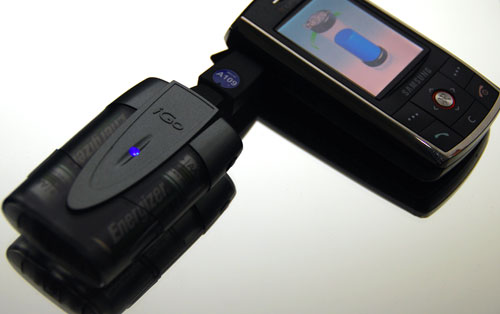
By Evan Ackerman
I have a tendency to complain a lot about batteries. I can accept the fact that batteries are a necessary evil, but do there have to be so darn many different kinds of them? I love rechargeable AAs because you can use the same batteries over and over in a lot of devices, but increasingly, new gadgets have integrated, customized, expensive lithium ion batteries. The iGo powerXtender is a brilliant little AA battery pack that, with the aid of iGo tips, you can plug into virtually anything to recharge and/or power it. The best news is that it costs all of $16; read my full review after the jump.
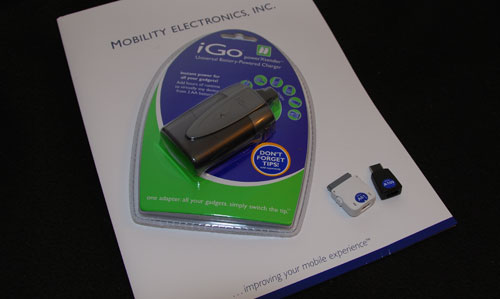
The iGo powerXtender comes in this curvy plastic package that requires a chainsaw to open. It includes 2 AA Duracell batteries, which is great, since you can use it right out of the box.
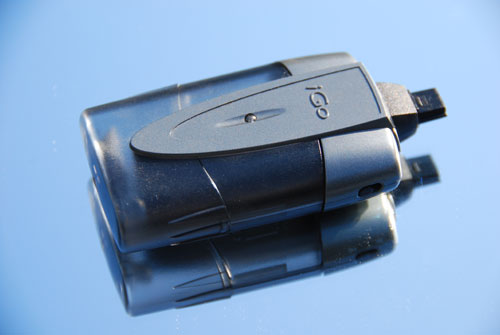
The powerXtender is made of heavy duty plastic, and pulls apart to allow access to the battery compartment, which takes up about 80% of the volume of the device. There’s a blue LED on top that indicates whether or not the device is charging, and there’s a teeny little recessed switch on the side to turn it on and off.
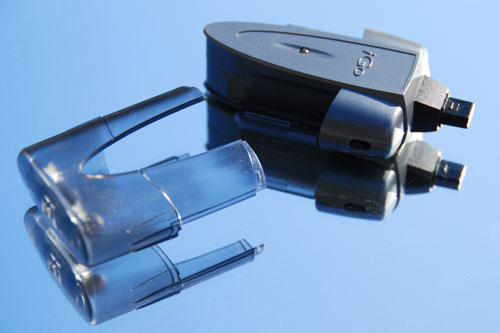
Well, you can almost use it right out of the box… You’re also going to need to get yourself a tip that matches the device you’d like to charge. Just to be clear, if you buy a powerXtender, it is useless as anything but a little plastic battery house without tips. They’ll run you about $10 each, and you should be able to buy them wherever you can buy the powerXtender itself. There are tons of them, and the odds are excellent that you’ll be able to find one for your stuff. The tips are really the heart of the whole iGo system: whenever you get a new gadget, you can use all of your iGo power accessories with it after purchasing a single new $10 tip. They’re like useful collectibles, it’s fun!
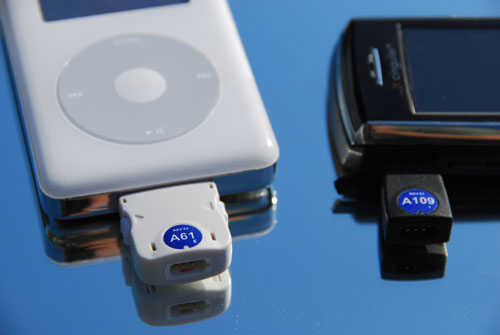
$10 might seem expensive for what looks like a little piece of plastic, but they’ve actually got some brains in there. I was a little bit concerned, at first, about how the charger knows what rate to charge my gadgets at, since my iPod and cell phone are generally charged at different rates and there’s no way to set that on the charger. Well, I asked about it, and it turns out that “the tips do all the brainwork by communicating with the charger about how much power the device needs to receive. By automatically configuring and regulating voltage and current, the need to adjust proper voltage on a multi-voltage charger is eliminated.” Clever.
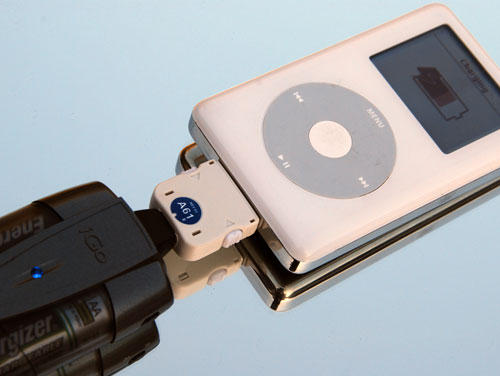
The first thing I tried the powerXtender on was my iPod, which had no bars in the battery indicator. It showed halfway charged in about 2 hours, and then powerXtender shut off. Toggling the switch on and off didn’t seem to do anything. Hmm. I took the batts out and put them back in again, turned it on, and let it keep charging. It lasted about half an hour this time, and shut off. I repeated the procedure and got another 5 minutes of juice. Weird. The manual does say that the “unit may shut off prematurely when used with select devices,” so I tried to on my cellphone next, and it worked for 30 seconds. I replaced the included Duracell AA batts that said “MAR 2013” on them with some Powerex rechargeables, which seemed to work better, but again shut themselves off after an hour or two. What I ultimately had to do was remove and replace the batteries whenever the unit shut itself off. I have no idea why this happens (overheating, perhaps?), but a brief search of the internets reveals that this problem is fairly common.
This quirk aside, with a fresh pack of Duracells, I got about 5 hours worth of charge time on my iPod, and a little over 6 on my cellphone, which is reasonably close to the 6-8 expected hours of charge. Using cheap batteries, you’ll get a little less, and “premium” batteries will get you a little more. Using a set of Powerex 2500 mAh rechargeables, I was able to fully charge my iPod nearly twice, but because of the temperamental nature of the powerXtender, it’s hard to tell whether the batteries are truly out of juice, or if the charger is just being difficult. It would be really really helpful if there was some sort of battery indicator on the powerXtender itself. ‘Course, if you’re using a bunch of different kinds of batteries in the thing, it probably wouldn’t mean much anyway, since rechargeables have a different voltage than alkalines.
One of the most useful things that the powerXtender allows is for you to use a device instantly if you’ve forgotten to charge completely. I’ve lost count of the number of times I’ve run out of the house with my iPod only to discover that it’s totally unresponsive. Having a powerXtender handy means that I don’t really have to worry about it anymore, since I can just plug the iPod right in. Ditto with my cell phone. Only problem is, the powerXtender then juts out inflexibly from the side or bottom of your device, rendering them more or less impractical if they’re supposed to be handheld. Even if there was just an inch or two of cord built in, it would make the combination far easier to use.
I was also able to test out the powerXtender and iGo tips with two accessories: a wall charger, and a splitter.
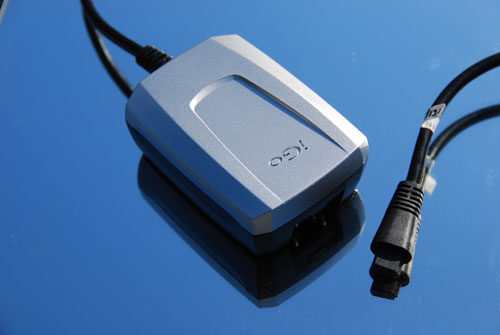
The wall charger costs $20 and is functionally the same as the powerXtender: just stick a tip on it, and go. It’s fairly unremarkable… The plug folds up to make it flatter for travel (good) but it’s fat enough to usually take up more than one outlet on a powerstrip (bad). For the life of me I can’t figure out WHY companies keep doing this. For $20, if you ever lose or break the charger that came with (say) your cell phone, spending $30 on an iGo wall charger and tip is (I think) definitely worth it, considering the options it gives you whenever you get some new electronic toy.
By far the coolest accessory is the power splitter:

I have two devices that I use pretty much every day: my cell phone, and my iPod. The $10 power splitter lets me charge both of them at the same, from either the powerXtender or the wall charger. Sure, when you hook up the powerXtender to charge two gadgets at the same time everything is going to charge slower, but they’re still going to work. And remember, since the brains (or whatever) are in the tips, you’re still charging everything at the proper voltages and stuff. I use this setup every day now, I kid you not.
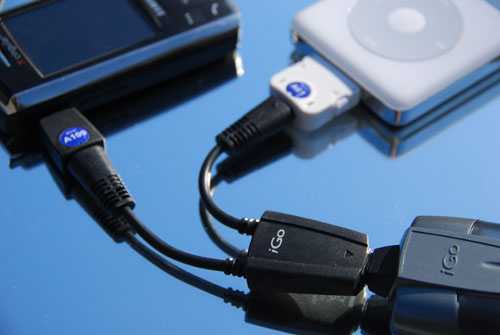
Pros:
The powerXtender is relatively cheap
You can to buy new iGo tips to maintain compatibility with all of your devices
Tips are compatible with a range of iGo power accessories
Uses any AA batteries, including rechargeables
Not much larger than the batteries inside it
Dead simple to operate
Cons:
Shuts itself off whenever it feels like
You have to buy new tips for all of your devices at $10 each
No way to determine how much juice is left in the batteries
Attaches to devices with an inflexible connection
Nutshell:
Combining the powerXtender with a set of rechargeable batteries lets you turn any device you have a tip for, into something that’s AA powered. It gives you the flexibility to power and/or recharge virtually any small electronic device no matter where you are. By the time you buy the tips you need it’s not going to be dirt cheap, but if it saves you from buying spare batteries or replacement power adapters, it’ll probably pay for itself in not too long.
[ iGo powerXtender ]




